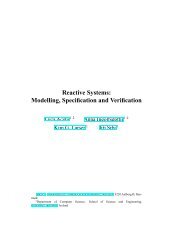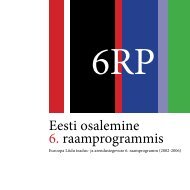Visiting Researcher's Guide - EURAXESS Estonia
Visiting Researcher's Guide - EURAXESS Estonia
Visiting Researcher's Guide - EURAXESS Estonia
You also want an ePaper? Increase the reach of your titles
YUMPU automatically turns print PDFs into web optimized ePapers that Google loves.
74<br />
8.6 Transportation in <strong>Estonia</strong><br />
The <strong>Estonia</strong>n traffic situation is not quite as<br />
intense as in the Mediterranean countries. It is<br />
true that the local roads, which are often narrow<br />
and rough, do not encourage speeding, which<br />
young hot-blooded drivers nevertheless engage in.<br />
Large and small <strong>Estonia</strong>n towns alike are generally<br />
characterised by a calm progression of vehicles and<br />
a plenitude of pedestrians. The inhabitants of the<br />
capital city encounter rush-hour traffic congestion<br />
and a shortage of parking spaces; in other towns<br />
the rush-hour is not as extensive.<br />
In case you do not have any business to conduct<br />
in different ends of Tallinn, you don’t need a car:<br />
the heart of the city is perfectly walkable. Trams,<br />
trolleys, buses and electric trains take you to the<br />
furthest corners of the city, although in the morning<br />
and evening the first three may force you into too<br />
close contact with your fellow passengers. In towns<br />
people use buses and minicabs which stick to their<br />
timetable quite closely. Buying a single ticket will<br />
not ruin anyone’s budget, but frequent travellers<br />
EVERYDAY NECESSITIES<br />
are advised to get a monthly public transport<br />
pass. The weak point in <strong>Estonia</strong>n urban public<br />
transport is the lack of night service, but this is<br />
compensated by reasonably priced taxis.<br />
On the whole, <strong>Estonia</strong>ns prefer to take the bus<br />
from one town to another: train connections are<br />
sparse, and some trains are uncomfortable, as in<br />
Soviet times. The rail network has repeatedly been<br />
re-constructed and thus enables anyone to have a<br />
pleasant bicycle trip along the railway beds, which<br />
date from the early and mid-20 th century. The old<br />
railway stations offer surprising sights. Remote<br />
rural areas around the old railway stations suffer<br />
from isolation: the reduction of train service has<br />
hit them hard.<br />
As a pedestrian you should know that in autumn<br />
and in winter you must wear a reflex reflector,<br />
which makes it possible for drivers to see you in<br />
the dark from a longer distance.

















